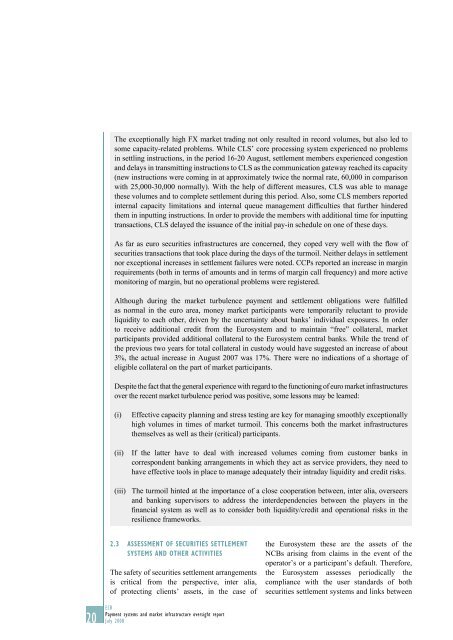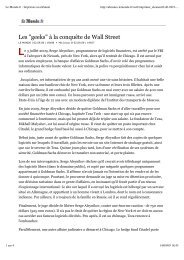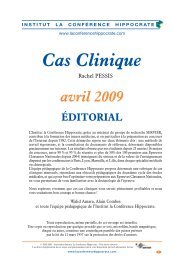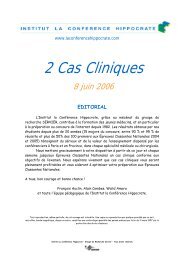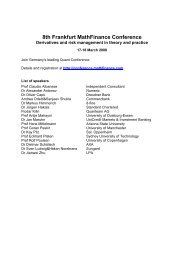Payment systems and market infrastructure oversight ... - Maths-fi.com
Payment systems and market infrastructure oversight ... - Maths-fi.com
Payment systems and market infrastructure oversight ... - Maths-fi.com
You also want an ePaper? Increase the reach of your titles
YUMPU automatically turns print PDFs into web optimized ePapers that Google loves.
The exceptionally high FX <strong>market</strong> trading not only resulted in record volumes, but also led to<br />
some capacity-related problems. While CLS’ core processing system experienced no problems<br />
in settling instructions, in the period 16-20 August, settlement members experienced congestion<br />
<strong>and</strong> delays in transmitting instructions to CLS as the <strong>com</strong>munication gateway reached its capacity<br />
(new instructions were <strong>com</strong>ing in at approximately twice the normal rate, 60,000 in <strong>com</strong>parison<br />
with 25,000-30,000 normally). With the help of different measures, CLS was able to manage<br />
these volumes <strong>and</strong> to <strong>com</strong>plete settlement during this period. Also, some CLS members reported<br />
internal capacity limitations <strong>and</strong> internal queue management dif<strong>fi</strong>culties that further hindered<br />
them in inputting instructions. In order to provide the members with additional time for inputting<br />
transactions, CLS delayed the issuance of the initial pay-in schedule on one of these days.<br />
As far as euro securities <strong>infrastructure</strong>s are concerned, they coped very well with the flow of<br />
securities transactions that took place during the days of the turmoil. Neither delays in settlement<br />
nor exceptional increases in settlement failures were noted. CCPs reported an increase in margin<br />
requirements (both in terms of amounts <strong>and</strong> in terms of margin call frequency) <strong>and</strong> more active<br />
monitoring of margin, but no operational problems were registered.<br />
Although during the <strong>market</strong> turbulence payment <strong>and</strong> settlement obligations were ful<strong>fi</strong>lled<br />
as normal in the euro area, money <strong>market</strong> participants were temporarily reluctant to provide<br />
liquidity to each other, driven by the uncertainty about banks’ individual exposures. In order<br />
to receive additional credit from the Eurosystem <strong>and</strong> to maintain “free” collateral, <strong>market</strong><br />
participants provided additional collateral to the Eurosystem central banks. While the trend of<br />
the previous two years for total collateral in custody would have suggested an increase of about<br />
3%, the actual increase in August 2007 was 17%. There were no indications of a shortage of<br />
eligible collateral on the part of <strong>market</strong> participants.<br />
Despite the fact that the general experience with regard to the functioning of euro <strong>market</strong> <strong>infrastructure</strong>s<br />
over the recent <strong>market</strong> turbulence period was positive, some lessons may be learned:<br />
(i)<br />
Effective capacity planning <strong>and</strong> stress testing are key for managing smoothly exceptionally<br />
high volumes in times of <strong>market</strong> turmoil. This concerns both the <strong>market</strong> <strong>infrastructure</strong>s<br />
themselves as well as their (critical) participants.<br />
(ii) If the latter have to deal with increased volumes <strong>com</strong>ing from customer banks in<br />
correspondent banking arrangements in which they act as service providers, they need to<br />
have effective tools in place to manage adequately their intraday liquidity <strong>and</strong> credit risks.<br />
(iii) The turmoil hinted at the importance of a close cooperation between, inter alia, overseers<br />
<strong>and</strong> banking supervisors to address the interdependencies between the players in the<br />
<strong>fi</strong>nancial system as well as to consider both liquidity/credit <strong>and</strong> operational risks in the<br />
resilience frameworks.<br />
2.3 ASSESSMENT OF SECURITIES SETTLEMENT<br />
SYSTEMS AND OTHER ACTIVITIES<br />
The safety of securities settlement arrangements<br />
is critical from the perspective, inter alia,<br />
of protecting clients’ assets, in the case of<br />
the Eurosystem these are the assets of the<br />
NCBs arising from claims in the event of the<br />
operator’s or a participant’s default. Therefore,<br />
the Eurosystem assesses periodically the<br />
<strong>com</strong>pliance with the user st<strong>and</strong>ards of both<br />
securities settlement <strong>systems</strong> <strong>and</strong> links between<br />
ECB<br />
<strong>Payment</strong> <strong>systems</strong> <strong>and</strong> <strong>market</strong> <strong>infrastructure</strong> <strong>oversight</strong> report<br />
20 July 2008


